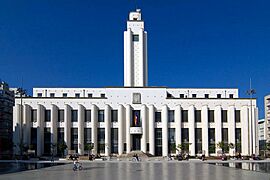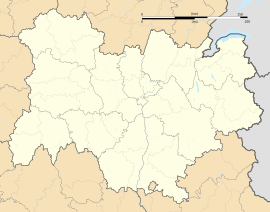Villeurbanne facts for kids
Quick facts for kids
Villeurbanne
Velorbana (Arpitan)
|
||
|---|---|---|

The city hall in Villeurbanne
|
||
|
||
| Country | France | |
| Region | Auvergne-Rhône-Alpes | |
| Metropolis | Metropolis of Lyon | |
| Arrondissement | Lyon | |
| Area
1
|
14.52 km2 (5.61 sq mi) | |
| Population
(2021)
|
156,928 | |
| • Density | 10,808/km2 (27,992/sq mi) | |
| Time zone | UTC+01:00 (CET) | |
| • Summer (DST) | UTC+02:00 (CEST) | |
| INSEE/Postal code |
69266 /69100
|
|
| Elevation | 165–189 m (541–620 ft) (avg. 181 m or 594 ft) |
|
| 1 French Land Register data, which excludes lakes, ponds, glaciers > 1 km2 (0.386 sq mi or 247 acres) and river estuaries. | ||
Villeurbanne is a large city in eastern France. It is located in the Metropolis of Lyon in the Auvergne-Rhône-Alpes region.
Villeurbanne is just northeast of Lyon. Together, these two cities form the second-largest metropolitan area in France, right after Paris. Villeurbanne is the second-biggest city in the Lyon area. It is also the 20th most populated city in all of France. In 2013, Villeurbanne was even named the city with the best local government in France! This has made it a very popular place to live.
Contents
Villeurbanne's Past: A Journey Through Time
The area where downtown Villeurbanne is today has been lived in for a very long time, since about 6000 BC. The city's name comes from a Roman-era farm. This farm was set up around the same time as Lyon (which was then called Lugdunum). The farm was known as the Villa Urbana, meaning "town house." Over time, this name changed to Urbanum, then Villa Urbane, and finally, Villeurbanne.
Since 1349, Villeurbanne has been part of the Kingdom of France. It used to be separated from a nearby area called La Guillotière by a river branch called La Rize. This river branch was part of the Rhône River.
Until the 1800s, Villeurbanne was mostly a collection of small villages. These villages were separated by fields and empty land. Many of these old villages still exist today. They are now neighborhoods like Charpennes, Cusset, and Croix-Luizet.
Growing with Industry: The 19th Century Boom
During the time of the Industrial Revolution, Villeurbanne's economy grew very quickly. The textile industry (making cloth) was the first to become big. After that, industries making machines and chemicals also started to grow. These new factories attracted many people to move to Villeurbanne, especially from Italy.
The 20th Century: A City Transformed
In the late 1920s, Villeurbanne changed a lot. It went from being a rural area to a busy industrial city. Its population grew hugely. In 1928, only 3,000 people lived there. But by 1931, the population had jumped to 82,000!
The mayor at that time, Lazare Goujon, was elected in 1924. He started many big public building projects in the city. One of the most famous results of his work is the Gratte-Ciel. This is a housing complex with two tall Art Deco towers. There are also smaller buildings along Avenue Henri Barbusse. These buildings were constructed between 1924 and 1934. They were designed by architect Môrice Leroux, with help from Tony Garnier. The Gratte-Ciel towers are important examples of Art Deco style in France. The 19-story twin towers have become a symbol of Villeurbanne.
The Villeurbanne city hall was built by Robert Giroud. He was a student of Tony Garnier (architect) and a friend of Môrice Leroux.
Learning in Villeurbanne: Schools and Universities
Villeurbanne has many schools and universities.
Primary and Secondary Schools
Here are some of the public junior high schools:
- Collège Louis Jouvet
- Collège Jean Jaurès
And some public senior high schools:
- Lycée Faÿs
- Lycée Alfred de Musset
- Lycée Marie Curie Villeurbanne
- Lycée Pierre Brossolette
- Lycée Magenta
There are also private schools:
- Institution Scolaire Immaculée Conception: This is a private school for all ages, from elementary to high school. It has three campuses.
- École Beth Menahem: This is a Jewish school for students from preschool to high school.
Colleges and Universities
Many colleges and universities from the Lyon area are located in Villeurbanne. A lot of them are on the La Doua campus. This campus is home to the Claude Bernard University (Lyon I), which is a public university. Also there are CPE Lyon and the Institut National des Sciences Appliquées de Lyon. This institute is one of France's top engineering schools, known for its excellent education and research.
Weekend Schools
The Association Pour le Developpement de la Langue et de la Culture Japonaises (ADLCJ) is a part-time Japanese supplementary school. It holds classes at the Maison Berty Albrecht in Villeurbanne. This school was started in 1987.
Getting Around: Transport in Villeurbanne
Villeurbanne has a good public transport system called TCL (Transports en Commun Lyonnais). The east part of subway line A goes right through the city center. Also, new tramway lines T1 and T4 connect the La Doua campus to Lyon's business area, La Part-Dieu, and the downtown area called Presqu'île.
Friendship Cities: Twin Towns
Villeurbanne has "twin town" relationships with other cities around the world. This means they are friendly and work together on cultural projects.
Villeurbanne also has a friendship agreement with:
 Stepanakert, Republic of Artsakh
Stepanakert, Republic of Artsakh
Population of Villeurbanne
| Historical population | ||||||||||||||||||||||||||||||||||||||||||||||||||||||||||||||||||||||||||||||||||||||||||||||||||||||||||||||||||||||
|---|---|---|---|---|---|---|---|---|---|---|---|---|---|---|---|---|---|---|---|---|---|---|---|---|---|---|---|---|---|---|---|---|---|---|---|---|---|---|---|---|---|---|---|---|---|---|---|---|---|---|---|---|---|---|---|---|---|---|---|---|---|---|---|---|---|---|---|---|---|---|---|---|---|---|---|---|---|---|---|---|---|---|---|---|---|---|---|---|---|---|---|---|---|---|---|---|---|---|---|---|---|---|---|---|---|---|---|---|---|---|---|---|---|---|---|---|---|---|
|
|
|||||||||||||||||||||||||||||||||||||||||||||||||||||||||||||||||||||||||||||||||||||||||||||||||||||||||||||||||||||
| From 1962, the number here is the population without double counting Source: EHESS and INSEE |
||||||||||||||||||||||||||||||||||||||||||||||||||||||||||||||||||||||||||||||||||||||||||||||||||||||||||||||||||||||
Villeurbanne is the second most populated city in the Metropolis of Lyon. It is the fourth largest in the Auvergne-Rhône-Alpes region and the 21st largest city in all of France.
Famous People from Villeurbanne
Many notable people were born or lived in Villeurbanne:
- Henry Bertrand, a silk weaver
- Henri Cochet (1901–1987), a tennis player
- Charles Hernu (1923–1990), a politician and mayor of Villeurbanne (1977–1990)
- Sébastien Philippe (born 1975), a racing car driver
- Mourad Benhamida (born 1986), a footballer
- Laure Manaudou (born 1986), a swimmer and world record holder
- Jean-Karl Vernay (born 1987), a race car driver
- Florent Manaudou (born 1990), a swimmer
- Gnonsiane Niombla (born 1990), a handball player
- Xavier Chavalerin (born 1991), a footballer
- Amos Youga (born 1992), a footballer
- Willem Geubbels (born 2001), a footballer
See also
 In Spanish: Villeurbanne para niños
In Spanish: Villeurbanne para niños









